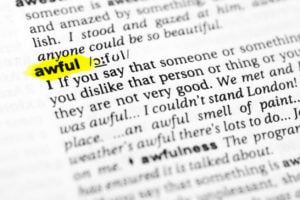Creating content that is effective and engaging on a number of different levels is an art form to be sure. It’s an art that can take years of practice and finetuning. But when we break down the anatomy of a blog post, we can see that there is also a science to it—a formula that we can use, time and time again, to create content that gets results.
The anatomy of a blog post functions, in many ways, like that of any other organism. Each part has its own unique job, but works in conjuction with the others to accomplish a common goal. By examining this anatomy, we can better understand the elements that make a post truly effective and can simplify the blog writing process to more quickly and easily write the content we need.

Attention-Grabbing Headline
Every effective post starts with an effective headline. Let this be your blog-writing mantra.
Too often, we get so caught up on the content we’re writing that we forget to really think our titles through. But the cold, hard truth is that 80 percent of readers will never make it past the headline. That’s a lot of readers that will never even get to that oh-so-carefully crafted content. That makes your headline your one big chance to grab the audience’s attention and convince them to read on.
Consider these things when crafting a headline that works:
- Keep title lengths right around 55 characters.
- Be clear about what your post aims to achieve.
- Focus on the first and last three words. (That’s what readers absorb the most.)
- Include a keyword.
- Use numbered lists, superlatives, and how-to’s.
Feature Image
Anatomically speaking, if your headline is, well, the head, your images are the face. They’re what give your post its visual appeal and can, literally, put a face to your content. But most importantly, they work.
According to Jeff Bullas, articles with images get 94 percent more views.
That’s right. 94 percent more views. That’s A LOT, and considering the effort-to-payoff ratio, you’d have to be crazy to publish a post without one.
Pictures make your blog instantly more effective and a whole lot more interesting. And in today’s increasingly visual digital world, where competition for readers grows every day, you’re only doing yourself a disservice by skimping on graphics.
When adding images to your blog posts, remember to:
- Choose high resolution photos to add credibility.
- Use pictures of people, when appropriate.
- Opt for engaging and relatable over generic.
- Purchase rights to your pictures or attribute them to the correct source.
Lead Paragraph
Your lead paragraph, much like your headline, should draw your readers in. It should be exciting, interesting, or shocking (maybe even all three!), but it should never be too windy or convoluted.
Get to the point. Tell the reader exactly what your post is about and what they can expect to gain from reading it.
Subheader
Subheaders are like the skeleton of your post. They provide structure and something for all those meaty, tidbits of information to hold on to.
Subheaders help break up the text of your post and make it more readable for your audience. A solid block of text on a screen can be intimidating and frankly, pretty unappealing. And for readers whose attention spans get smaller with every meme and baby animal video (you’re welcome), it’s important to break things down into smaller, more digestible bites.
Main Content
This is where you finally dig into the body of your post. Everything up until now has been leading the reader here.
Be sure to make the main content scannable for your reader so they can easily pick out the most important points, even if they don’t read your post word for word. (Hint: they probably won’t.)
Whenever possible, try to incorporate:
- bullet points
- numbered lists
- pull quotes
- charts or infographics
*At this point, you’ll probably want to repeat the subheader and main content processes a couple times, like we’ve done throughout this post.
Call to Action
Ultimately, you want your reader to take a next step once they’ve read your post. Whether that step is signing up for your newsletter, downloading an ebook, or watching a webinar, you want to take the reader by the hand and show them the way.
Keep it simple. Include a basic graphic, a few bright colors, and a clear, concise call to action. That’s it.
Instead of leaving those actions up to chance, CTAs increase conversion rates by giving the reader a clear path to where they should go next.
Social Sharing Buttons
The final part that makes up the anatomy of an effective blog post is your social sharing tabs. Ideally, you’d like to be creating content that engages your readers and prompts them to share it with their own social circles. And the easier you make it for your audience to share a post, the more likely it is that they will.
Your social sharing buttons can go in the footer, header, somewhere in the sidebar, or you can create buttons that float around the page as your reader scrolls. Just be sure they are placed somewhere visible, without being distracting.
Every effective blog post follows the same basic formula. Though filling in those gaps isn’t always easy, if you incorporate all of the elements mentioned above, you’ll be able to write more quickly, effectively, and efficiently in the future.



